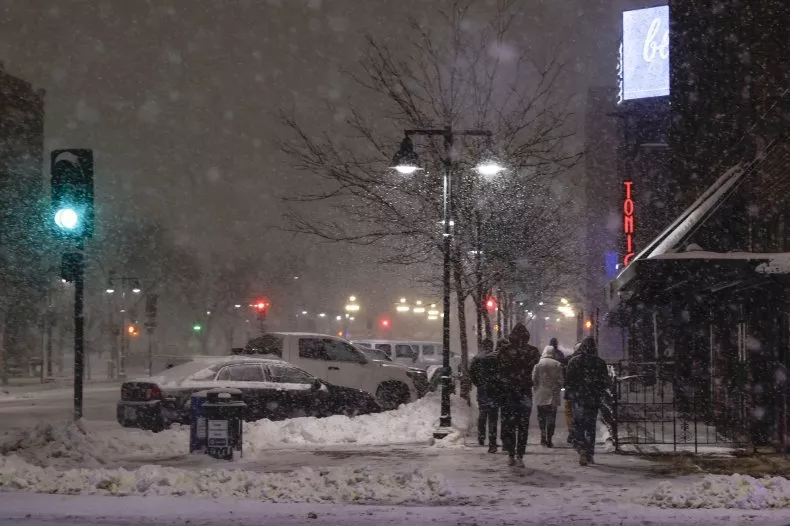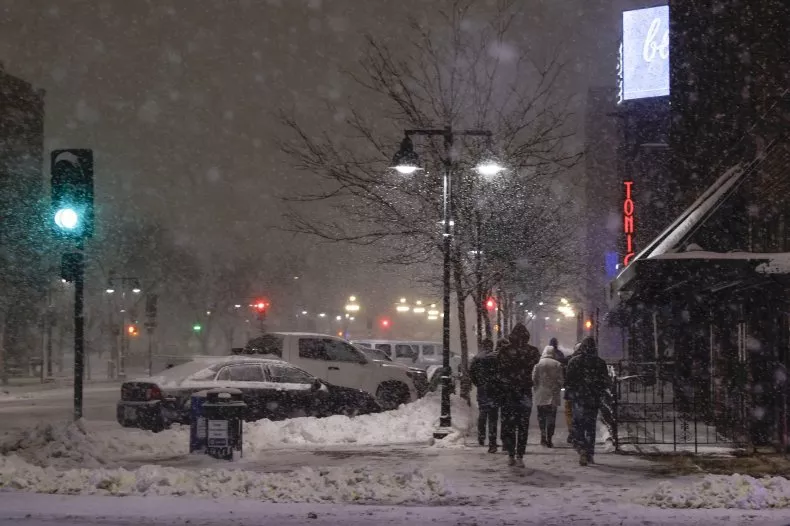A winter storm warning is currently in effect for parts of 13 states, as meteorologists anticipate the arrival of a cold weather front originating from the southwest. The system is expected to move across the Central Plains and Great Lakes on Thursday, impacting the northwest with ongoing Pacific storms.

The National Weather Service (NWS) has issued alerts for Alaska, Idaho, Iowa, Illinois, Minnesota, Montana, Nebraska, Nevada, Oregon, Utah, Washington, Wisconsin, and Wyoming. These warnings highlight the potential for “bitterly cold” air, challenging travel conditions, and whiteout scenarios in certain areas.
The NWS’s latest forecast indicates that “frigid” temperatures will persist into Friday in both the north-central and northwest regions. Additionally, concerns about flooding persist along the northeast coastline.
Looking ahead to Saturday, a major winter storm is predicted to bring blizzard conditions from eastern Nebraska to central Michigan. Widespread snowfall totals of 6-12 inches are expected within this Midwest corridor, with the potential for over a foot of snow in northern Lower Michigan.
The storm, which initially affected western central states earlier in the week, is now shifting northeastward towards the central Midwest and Great Lakes. Lingering cold weather remains in west central Nevada, where up to eight inches of snow is expected, accompanied by winds reaching up to 45 miles per hour.
In the Wasatch Mountains of central Utah, there’s a possibility of up to two feet of snow, coupled with wind gusts of 60 miles per hour. Far southwest Wyoming may experience up to a foot of snow, while the Sierra Madre and Snowy ranges of Wyoming could see accumulations of up to 10 inches.
As the cold front advances into the upper Midwest, eastern Nebraska and western Iowa may witness up to 10 inches of snow, with high winds potentially producing wind chills of minus 35 degrees Fahrenheit. The Quad Cities region is also expected to accumulate up to 10 inches of snow, along with a tenth of an inch of ice and winds reaching 50 miles per hour, impacting Friday’s commutes. Freezing rain is also a possibility.
Southeast Minnesota and southwest Wisconsin are anticipated to receive up to 10 inches of snow, with high winds causing blowing snow and occasional whiteout conditions. The region may experience wind chills as low as minus 30 degrees.
In the northwest, heavy precipitation from two recent atmospheric river storms brought rare blizzard warnings to areas surrounding Seattle on Monday and Tuesday. While the worst of the winter weather has temporarily abated, heavy snowfall is expected to persist across the Cascades of Washington and Oregon, with potential accumulations of up to four feet of snow and wind gusts as high as 50 miles per hour.
Similar conditions are forecasted for southeast Washington and northeast Oregon, where the Blue Mountains may experience 32 inches of snow and winds as high as 55 miles per hour.
Winter storm warnings are in effect for much of northern Idaho, where valleys could see up to 18 inches of snow and mountains up to 30 inches.
Western parts of Montana are also affected, with up to 20 inches of snow and wind chills as low as minus 60 degrees. The NWS warns that travel could be “very difficult to impossible,” with the danger of frostbite on exposed skin in as little as five minutes.
In western central Alaska, heavy snow and periods of blizzard conditions are anticipated, reducing visibility to a quarter of a mile or less.
These weather patterns come after several bouts of snowfall in western states this winter, following a “prolific series” of atmospheric river storms in December. Last winter, the West Coast experienced similar weather patterns, with California facing multiple rounds of flooding. Stay informed and stay safe during this winter weather period.
